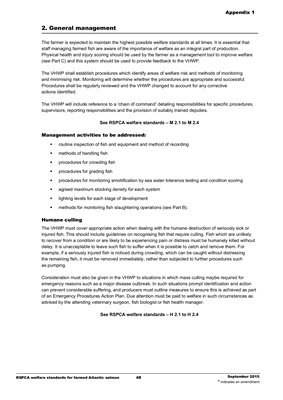
Appendix 1
RSPCA welfare standards for farmed Atlantic salmon 48 September 2015
* indicates an amendment
2. General management
The farmer is expected to maintain the highest possible welfare standards at all times. It is essential that
staff managing farmed fish are aware of the importance of welfare as an integral part of production.
Physical health and injury scoring should be used by the farmer as a management tool to improve welfare
(see Part C) and this system should be used to provide feedback to the VHWP.
The VHWP shall establish procedures which identify areas of welfare risk and methods of monitoring
and minimising risk. Monitoring will determine whether the procedures are appropriate and successful.
Procedures shall be regularly reviewed and the VHWP changed to account for any corrective
actions identified.
The VHWP will include reference to a 'chain of command' detailing responsibilities for specific procedures,
supervisors, reporting responsibilities and the provision of suitably trained deputies.
See RSPCA welfare standards - M 2.1 to M 2.4
Management activities to be addressed:
routine inspection of fish and equipment and method of recording
methods of handling fish
procedures for crowding fish
procedures for grading fish
procedures for monitoring smoltification by sea water tolerance testing and condition scoring
agreed maximum stocking density for each system
lighting levels for each stage of development
methods for monitoring fish slaughtering operations (see Part B).
Humane culling
The VHWP must cover appropriate action when dealing with the humane destruction of seriously sick or
injured fish. This should include guidelines on recognising fish that require culling. Fish which are unlikely
to recover from a condition or are likely to be experiencing pain or distress must be humanely killed without
delay. It is unacceptable to leave such fish to suffer when it is possible to catch and remove them. For
example, if a seriously injured fish is noticed during crowding, which can be caught without distressing
the remaining fish, it must be removed immediately, rather than subjected to further procedures such
as pumping.
Consideration must also be given in the VHWP to situations in which mass culling maybe required for
emergency reasons such as a major disease outbreak. In such situations prompt identification and action
can prevent considerable suffering, and producers must outline measures to ensure this is achieved as part
of an Emergency Procedures Action Plan. Due attention must be paid to welfare in such circumstances as
advised by the attending veterinary surgeon, fish biologist or fish health manager.
See RSPCA welfare standards - H 2.1 to H 2.4